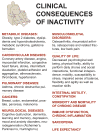The role of exercise and PGC1alpha in inflammation and chronic disease
- PMID: 18650917
- PMCID: PMC2587487
- DOI: 10.1038/nature07206
The role of exercise and PGC1alpha in inflammation and chronic disease
Abstract
Inadequate physical activity is linked to many chronic diseases. But the mechanisms that tie muscle activity to health are unclear. The transcriptional coactivator PGC1alpha has recently been shown to regulate several exercise-associated aspects of muscle function. We propose that this protein controls muscle plasticity, suppresses a broad inflammatory response and mediates the beneficial effects of exercise.
Figures




Similar articles
-
Suppression of plasma free fatty acids upregulates peroxisome proliferator-activated receptor (PPAR) alpha and delta and PPAR coactivator 1alpha in human skeletal muscle, but not lipid regulatory genes.J Mol Endocrinol. 2004 Oct;33(2):533-44. doi: 10.1677/jme.1.01499. J Mol Endocrinol. 2004. PMID: 15525607
-
Skeletal Muscle PGC1α -1 Nucleosome Position and -260 nt DNA Methylation Determine Exercise Response and Prevent Ectopic Lipid Accumulation in Men.Endocrinology. 2017 Jul 1;158(7):2190-2199. doi: 10.1210/en.2017-00051. Endocrinology. 2017. PMID: 28398573 Free PMC article.
-
Peroxisome proliferator-activated receptor-gamma coactivator-1alpha in muscle links metabolism to inflammation.Clin Exp Pharmacol Physiol. 2009 Dec;36(12):1139-43. doi: 10.1111/j.1440-1681.2009.05275.x. Epub 2009 Aug 4. Clin Exp Pharmacol Physiol. 2009. PMID: 19671064 Review.
-
Aging and its effects on inflammation in skeletal muscle at rest and following exercise-induced muscle injury.Am J Physiol Regul Integr Comp Physiol. 2010 Jun;298(6):R1485-95. doi: 10.1152/ajpregu.00467.2009. Epub 2010 Apr 14. Am J Physiol Regul Integr Comp Physiol. 2010. PMID: 20393160 Review.
-
Intercellular: local and systemic actions of skeletal muscle PGC-1s.Trends Endocrinol Metab. 2015 Jun;26(6):305-14. doi: 10.1016/j.tem.2015.03.010. Epub 2015 Apr 28. Trends Endocrinol Metab. 2015. PMID: 25934582 Review.
Cited by
-
Macrophage Mitochondrial Energy Status Regulates Cholesterol Efflux and Is Enhanced by Anti-miR33 in Atherosclerosis.Circ Res. 2015 Jul 17;117(3):266-78. doi: 10.1161/CIRCRESAHA.117.305624. Epub 2015 May 22. Circ Res. 2015. PMID: 26002865 Free PMC article.
-
The Foxo1-YAP-Notch1 axis reprograms STING-mediated innate immunity in NASH progression.Exp Mol Med. 2024 Aug;56(8):1843-1855. doi: 10.1038/s12276-024-01280-5. Epub 2024 Aug 9. Exp Mol Med. 2024. PMID: 39122845 Free PMC article.
-
Contractile activity of human skeletal muscle cells prevents insulin resistance by inhibiting pro-inflammatory signalling pathways.Diabetologia. 2012 Apr;55(4):1128-39. doi: 10.1007/s00125-012-2454-z. Epub 2012 Jan 27. Diabetologia. 2012. PMID: 22282161
-
The relation of peripheral and central sensitization to muscle co-contraction: the MOST study.Osteoarthritis Cartilage. 2020 Sep;28(9):1214-1219. doi: 10.1016/j.joca.2020.06.002. Epub 2020 Jun 23. Osteoarthritis Cartilage. 2020. PMID: 32585174 Free PMC article.
-
The Role of PGC1α in Alzheimer's Disease and Therapeutic Interventions.Int J Mol Sci. 2021 May 28;22(11):5769. doi: 10.3390/ijms22115769. Int J Mol Sci. 2021. PMID: 34071270 Free PMC article. Review.
References
-
- Booth FW, Chakravarthy MV, Gordon SE, Spangenburg EE. Waging war on physical inactivity: using modern molecular ammunition against an ancient enemy. J Appl Physiol. 2002;93(1):3–30. - PubMed
-
- Erikssen G, et al. Changes in physical fitness and changes in mortality. Lancet. 1998;352(9130):759–762. - PubMed
-
- Hu FB, et al. Adiposity as compared with physical activity in predicting mortality among women. N Engl J Med. 2004;351(26):2694–2703. - PubMed
-
- Kokkinos P, et al. Exercise capacity and mortality in black and white men. Circulation. 2008;117(5):614–622. - PubMed
-
- Booth FW, Lees SJ. Fundamental questions about genes, inactivity, and chronic diseases. Physiol Genomics. 2007;28(2):146–157. - PubMed
Publication types
MeSH terms
Substances
Grants and funding
LinkOut - more resources
Full Text Sources
Other Literature Sources
Medical
Miscellaneous

